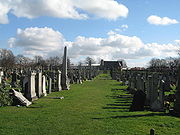
Toxteth Park Cemetery
Encyclopedia

Smithdown Road, Liverpool
Smithdown Road is a street in Liverpool, England, which forms part of the A562. It is the location of Toxteth Park Cemetery and Wavertree Playground. Penny Lane junction, the subject of The Beatles song Penny Lane, is situated at the junction of Smithdown Road, Smithdown Place and Penny Lane...
, Liverpool
Liverpool
Liverpool is a city and metropolitan borough of Merseyside, England, along the eastern side of the Mersey Estuary. It was founded as a borough in 1207 and was granted city status in 1880...
, United Kingdom
United Kingdom
The United Kingdom of Great Britain and Northern IrelandIn the United Kingdom and Dependencies, other languages have been officially recognised as legitimate autochthonous languages under the European Charter for Regional or Minority Languages...
. It was opened on Monday 9 June 1856. It was the responsibility of the Toxteth Park Burial Board, which had been established by at least 1855.
The opening ceremony was performed by the then Lord Bishop of Chester
Bishop of Chester
The Bishop of Chester is the Ordinary of the Church of England Diocese of Chester in the Province of York.The diocese expands across most of the historic county boundaries of Cheshire, including the Wirral Peninsula and has its see in the City of Chester where the seat is located at the Cathedral...
, and the first interment took place, that of an Elizabeth Watling on 17th June 1856.
The cemetery was built with consecrated
Cemetery
A cemetery is a place in which dead bodies and cremated remains are buried. The term "cemetery" implies that the land is specifically designated as a burying ground. Cemeteries in the Western world are where the final ceremonies of death are observed...
and unconsecrated areas, and the layout, featuring walks, was by a "Mr Gay of Bradford
Bradford
Bradford lies at the heart of the City of Bradford, a metropolitan borough of West Yorkshire, in Northern England. It is situated in the foothills of the Pennines, west of Leeds, and northwest of Wakefield. Bradford became a municipal borough in 1847, and received its charter as a city in 1897...
cemetery".
It was taken over by Liverpool Corporation on 1 January 1905.
Records
The cemetery's records are held on microfilm in the Liverpool Record Office, and provide the Burial Registers and the Order Books.Structures
Various buildings at the cemetery are Grade II listed buildings. In addition to the significant number of obeliskObelisk
An obelisk is a tall, four-sided, narrow tapering monument which ends in a pyramid-like shape at the top, and is said to resemble a petrified ray of the sun-disk. A pair of obelisks usually stood in front of a pylon...
and Celtic cross
Celtic cross
A Celtic cross is a symbol that combines a cross with a ring surrounding the intersection. In the Celtic Christian world it was combined with the Christian cross and this design was often used for high crosses – a free-standing cross made of stone and often richly decorated...
gravestones in the cemetery, there is a derelict chapel, and a pair of lodges or gatehouses at the Smithdown Road entrance. The cemetery also contains Toxteth War Memorial
War memorial
A war memorial is a building, monument, statue or other edifice to celebrate a war or victory, or to commemorate those who died or were injured in war.-Historic usage:...
.
To the rear, the cemetery bounds the back gardens of houses on Arundel Avenue, and can be accessed through turnstiles in an ornate gateway set back from that road at the end of a short lane. On the easterly lodge at the main entrance at Smithdown Road there is a sign with provision for the insertion of digits indicating the time of evening at which these rear entrance turnstiles will be closed, but for some time this sign has been disused, as this lodge also appears to be (the westerly lodge being inhabited and, as of spring 2009, up for auction.)
Neighbours
At the eastern end of the high southern boundary wall, where the cemetery ends and the grounds of a supermarket, a medical clinic, and modern houses begin, the high wall continues but the style of brickwork can be seen to change; this area now occupied by the aforementioned modern buildings was previously the Toxteth Park WorkhouseWorkhouse
In England and Wales a workhouse, colloquially known as a spike, was a place where those unable to support themselves were offered accommodation and employment...
, which was built in 1859 by the Toxteth Park Board of Guardians as part of the West Derby Union. In 1923 the workhouse changed its name to the Smithdown Road Institution; in 1930 the Poor Law
Poor Law
The English Poor Laws were a system of poor relief which existed in England and Wales that developed out of late-medieval and Tudor-era laws before being codified in 1587–98...
was abolished and the Union was disbanded, so the hospital was taken over by Liverpool Corporation. In 1933, its name was changed to Smithdown Road Infirmary, and in about 1950 its name was changed again, to Sefton General Hospital. Most of it was demolished in 2001 but a part of the original workhouse hospital, Arundel House, still stands.

